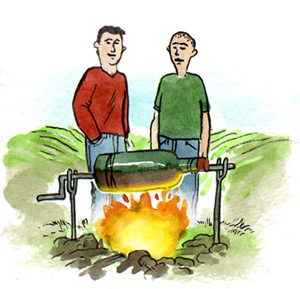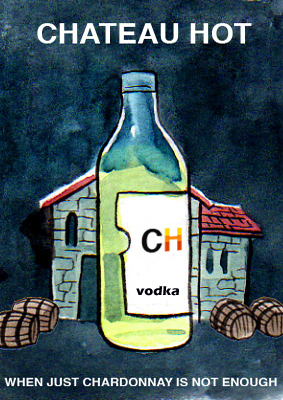

Okay, so wine is not exactly cooked but rising alcohol levels definitely make it hot and many U.S. consumers like it that way.
Some Like It Hot
Technology Columnist Clark Smith weighs in on the evolution of high alcohol -‘hot’ - wines and why they are the rule, not the exception in the U.S.
by
Clark Smith
September 10, 2007
Wine alcohol levels certainly are climbing. Elin McCoy reported in her Bloomberg column, “High-Octane Wine Fashion Craze Provokes Dumping, Rebellion,” that her survey of California wine labels indicates a rise from 12.5 percent in 1971 to a 14.8 percent average in 2001. Mind you, back then, common practice was to print multiple vintages of labels (with the vintage on a neck label) and to show the alcohol as 12.5 percent, taking advantage of the 1.5 percent federal leeway below 14 percent. But Australian Wine Research Institute figures show the same trend for their wines based on actual analysis: from 12.8 in 1975 to 14.5 percent today.
I should point out that, in terms of ripeness, the trend is much more drastic than the numbers indicate because of the new alcohol adjustment technologies which Conetech and my own company Vinovation have popularized in the last decade. Together we take an average of over 1 percent alcohol from 45 percent of the California wines you buy. So in terms of actual alcohol at the end of fermentation, the average in 2001 was well over 15 percent.
Where is this alcohol coming from? Countless articles have recently emerged on this topic, each with its own novel slant. Let’s look over some reasons offered up in the popular press for this trend, and then I’ll take us behind the scenes into the minds of today’s winemakers.
Are we seeing another artifact of climate change, somehow raising the sugar in our fruit? In its December 2006 issue article about the rise of the emerging
What’s next for wine as alcohol levels rise? Chardonnay Vodka?Tulucay appellation Cabernet, Wine and Spirits Magazine implicates global warming in the rise of Howell Mountain alcohols and the rush to the cool end of Napa. At $100, my own WineSmith Crucible Cabernet Sauvignon certainly benefits from dialing in its source vineyards in the region to maximize tannin density and deep ripe flavors. But with due respect to Al Gore’s consciousness promoting efforts, Napa town is still quite chilly. Experimental plantings at Napa Valley College reveal that the secret to the region is clonal. Clone 337 Cabernet comes in there at 25 Brix with huge dimensions and great color, three weeks before up-valley champion Clone 7, planted right beside it, reports in as a wimpy, weedy Beaujolais at 21.5 Brix. In fact, the rising heat of the Central Valley is pulling in more ocean air, rendering the South Valley cooler, not warmer.
Are the new super yeasts to blame? Yes and no. Yeast strains can’t change the conversion ratio of sugar to alcohol, at least not very much. The six carbon atoms in a sugar molecule have to go somewhere. Two atoms end up as carbon dioxide. The other four go to ethyl alcohol plus miniscule amounts of other flavors like glycerol and to the growth of the yeasts themselves. To change alcohol by 1 percent would mean 17 grams per liter of sugar came from somewhere else – an enormous amount. And super yeasts make more cell mass, not less, thus lowering alcohol.
However, these ultra-vigorous yeasts do permit us to ferment grapes to dryness which in the old days would have stuck sweet. So they do indeed open up the door for harvesting grapes with very high sugar content. But why would we wish to do that?
Some say today’s vines are grown so artificially that they fail to achieve the natural balance required to get ripe flavors at normal alcohols, and that our wines won’t reflect balance until we embrace organics. In his article entitled The Science of Sustainable Viticulture, John Williams of Frog’s Leap indicts excessive inorganic fertilizer and over irrigation in a host of wine quality issues and reports that balancing soil fertility and abandoning sterol inhibitors and dimethoate now gives him flavors at 23.5 Brix he didn’t used to see until 28 Brix.
I have no doubt that John is exactly right. But these practices were even more rampant in the ‘70’s than they are today. And they don’t account for the catastrophes which befell long-established Barolo producers in 1997, who deliberately chose to let the fruit on their beautifully balanced vineyards hang until the resulting wines lasted less than a decade. I’m afraid that, at its root, ripeness craziness is more a mental disease than a reaction to some physical disorder. Like alcohol dependency itself, a good thing pushed too far.
So what caused the shift in California’s alcohols? An obvious first answer is that the kind of wine the New World has come to specialize in isn’t the Rhinewine, Chablis and rosé that California wineries were dishing up in the 1970’s, when the principal wine grape was Thompson Seedless. The largest selling table wines in the U.S. during that period are shown in the chart on the right: All low alcohol European or Euro-style quaffables.
Over the next thirty years, the wine Americans drank shifted toward California while simultaneously the State’s production has been boosting the wallop it packs. But to chalk up the change in table wine alcohol content to shifts in stylistic preference is almost a circular argument. Wines got bigger because they got bigger?
High alcohols from New World producers aren’t a new thing. In fact, if you go back to 1951, you’d find the average in both California and Australia would be over 18 percent! That’s because at that time, wine consumers, when they drank domestic wine at all, drank almost entirely port, sherry and muscatel. A miniscule group at the upper end who drank French and a few German table wines didn’t believe domestic stuff was worth considering. So California wine at that time was over 90 percent fortified, and Chardonnay was almost unplanted. Our few wine lovers went through maybe a bottle a year of port and sherry, and the rest was light European wines. So what brought about the shift to more potent table wines as standard California fare?
Let’s examine the story of that wonderful period during which the fledgling California Serious Wine Industry created itself. Winemaking style evolution
New Tariff in Town
Drinking stronger doesn’t mean drinking more. According to the World Health Organization, Americans decreased their overall per capita alcohol consumption by over 20 percent from 1980 to 2000. We’re drinking less and enjoying it more, but maybe compensating a bit by shifting buying preferences to stronger stuff. Without a doubt, there was a shift in the ‘80’s from light wines – mostly white and rosé and usually a little sweet - to bigger, drier styles like Chardonnay and the big reds as wineries lured hard liquor drinkers away from spirits. And when the federal tax on a gallon of wine soared in 1984 from 17¢ to $1.07, gallon jug prices tripled overnight from $2 to $6 and former jug drinkers shifted to 750 ml, while wine consumption plunged from 12 liters per capita to 8 liters the following year.I should point out that, in terms of ripeness, the trend is much more drastic than the numbers indicate because of the new alcohol adjustment technologies which Conetech and my own company Vinovation have popularized in the last decade. Together we take an average of over 1 percent alcohol from 45 percent of the California wines you buy. So in terms of actual alcohol at the end of fermentation, the average in 2001 was well over 15 percent.
Where is this alcohol coming from? Countless articles have recently emerged on this topic, each with its own novel slant. Let’s look over some reasons offered up in the popular press for this trend, and then I’ll take us behind the scenes into the minds of today’s winemakers.
Are we seeing another artifact of climate change, somehow raising the sugar in our fruit? In its December 2006 issue article about the rise of the emerging

What’s next for wine as alcohol levels rise? Chardonnay Vodka?
Are the new super yeasts to blame? Yes and no. Yeast strains can’t change the conversion ratio of sugar to alcohol, at least not very much. The six carbon atoms in a sugar molecule have to go somewhere. Two atoms end up as carbon dioxide. The other four go to ethyl alcohol plus miniscule amounts of other flavors like glycerol and to the growth of the yeasts themselves. To change alcohol by 1 percent would mean 17 grams per liter of sugar came from somewhere else – an enormous amount. And super yeasts make more cell mass, not less, thus lowering alcohol.
However, these ultra-vigorous yeasts do permit us to ferment grapes to dryness which in the old days would have stuck sweet. So they do indeed open up the door for harvesting grapes with very high sugar content. But why would we wish to do that?
Some say today’s vines are grown so artificially that they fail to achieve the natural balance required to get ripe flavors at normal alcohols, and that our wines won’t reflect balance until we embrace organics. In his article entitled The Science of Sustainable Viticulture, John Williams of Frog’s Leap indicts excessive inorganic fertilizer and over irrigation in a host of wine quality issues and reports that balancing soil fertility and abandoning sterol inhibitors and dimethoate now gives him flavors at 23.5 Brix he didn’t used to see until 28 Brix.
I have no doubt that John is exactly right. But these practices were even more rampant in the ‘70’s than they are today. And they don’t account for the catastrophes which befell long-established Barolo producers in 1997, who deliberately chose to let the fruit on their beautifully balanced vineyards hang until the resulting wines lasted less than a decade. I’m afraid that, at its root, ripeness craziness is more a mental disease than a reaction to some physical disorder. Like alcohol dependency itself, a good thing pushed too far.
We Have Met the Enemy and He is Us
Bestselling Wines of the 1970’s
1970 Lancer’s Rosé
1971 Mateus Rosé
1972 Blue Nun
1973 Wente Grey Riesling
1974 Reunite Lambrusco
1975 Bolla Soave
1976 Fontana Candida Frascati
Over the next thirty years, the wine Americans drank shifted toward California while simultaneously the State’s production has been boosting the wallop it packs. But to chalk up the change in table wine alcohol content to shifts in stylistic preference is almost a circular argument. Wines got bigger because they got bigger?
High alcohols from New World producers aren’t a new thing. In fact, if you go back to 1951, you’d find the average in both California and Australia would be over 18 percent! That’s because at that time, wine consumers, when they drank domestic wine at all, drank almost entirely port, sherry and muscatel. A miniscule group at the upper end who drank French and a few German table wines didn’t believe domestic stuff was worth considering. So California wine at that time was over 90 percent fortified, and Chardonnay was almost unplanted. Our few wine lovers went through maybe a bottle a year of port and sherry, and the rest was light European wines. So what brought about the shift to more potent table wines as standard California fare?
Let’s examine the story of that wonderful period during which the fledgling California Serious Wine Industry created itself. Winemaking style evolution










 READER FEEDBACK: To post your comments on this story,
READER FEEDBACK: To post your comments on this story,




